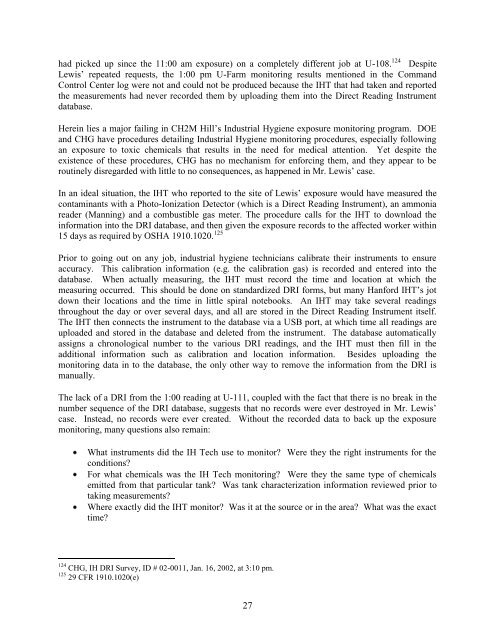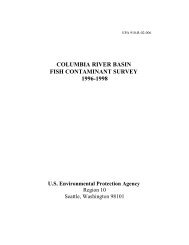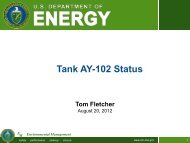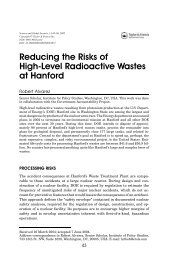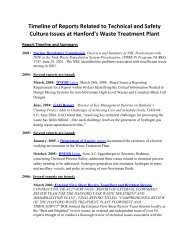Knowing Endangerment - Hanford Challenge
Knowing Endangerment - Hanford Challenge
Knowing Endangerment - Hanford Challenge
You also want an ePaper? Increase the reach of your titles
YUMPU automatically turns print PDFs into web optimized ePapers that Google loves.
had picked up since the 11:00 am exposure) on a completely different job at U-108. 124 Despite<br />
Lewis‟ repeated requests, the 1:00 pm U-Farm monitoring results mentioned in the Command<br />
Control Center log were not and could not be produced because the IHT that had taken and reported<br />
the measurements had never recorded them by uploading them into the Direct Reading Instrument<br />
database.<br />
Herein lies a major failing in CH2M Hill‟s Industrial Hygiene exposure monitoring program. DOE<br />
and CHG have procedures detailing Industrial Hygiene monitoring procedures, especially following<br />
an exposure to toxic chemicals that results in the need for medical attention. Yet despite the<br />
existence of these procedures, CHG has no mechanism for enforcing them, and they appear to be<br />
routinely disregarded with little to no consequences, as happened in Mr. Lewis‟ case.<br />
In an ideal situation, the IHT who reported to the site of Lewis‟ exposure would have measured the<br />
contaminants with a Photo-Ionization Detector (which is a Direct Reading Instrument), an ammonia<br />
reader (Manning) and a combustible gas meter. The procedure calls for the IHT to download the<br />
information into the DRI database, and then given the exposure records to the affected worker within<br />
15 days as required by OSHA 1910.1020. 125<br />
Prior to going out on any job, industrial hygiene technicians calibrate their instruments to ensure<br />
accuracy. This calibration information (e.g. the calibration gas) is recorded and entered into the<br />
database. When actually measuring, the IHT must record the time and location at which the<br />
measuring occurred. This should be done on standardized DRI forms, but many <strong>Hanford</strong> IHT‟s jot<br />
down their locations and the time in little spiral notebooks. An IHT may take several readings<br />
throughout the day or over several days, and all are stored in the Direct Reading Instrument itself.<br />
The IHT then connects the instrument to the database via a USB port, at which time all readings are<br />
uploaded and stored in the database and deleted from the instrument. The database automatically<br />
assigns a chronological number to the various DRI readings, and the IHT must then fill in the<br />
additional information such as calibration and location information. Besides uploading the<br />
monitoring data in to the database, the only other way to remove the information from the DRI is<br />
manually.<br />
The lack of a DRI from the 1:00 reading at U-111, coupled with the fact that there is no break in the<br />
number sequence of the DRI database, suggests that no records were ever destroyed in Mr. Lewis‟<br />
case. Instead, no records were ever created. Without the recorded data to back up the exposure<br />
monitoring, many questions also remain:<br />
What instruments did the IH Tech use to monitor? Were they the right instruments for the<br />
conditions?<br />
For what chemicals was the IH Tech monitoring? Were they the same type of chemicals<br />
emitted from that particular tank? Was tank characterization information reviewed prior to<br />
taking measurements?<br />
Where exactly did the IHT monitor? Was it at the source or in the area? What was the exact<br />
time?<br />
124 CHG, IH DRI Survey, ID # 02-0011, Jan. 16, 2002, at 3:10 pm.<br />
125 29 CFR 1910.1020(e)<br />
27


